Almond Cow
Nut Milk Maker
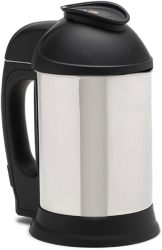
Vitamix 7500
CR's Top Pick
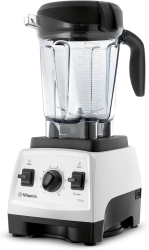
Wolf Gourmet
CR's Second Pick
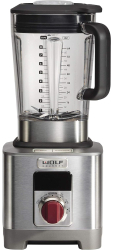
Cheesecloth
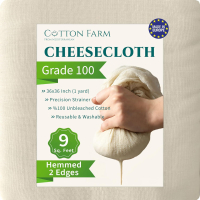
Nut Milk Bag
Fine Mesh Nylon Cloth
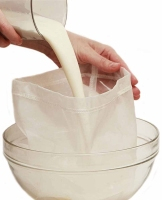
Almond Milks
Almond Milk in Vitamix
1/3 c. plain raw almonds
about 3 c. water
1-3 large pitted dates
Soak the almonds in water to cover for a day or two in the refrigerator.
When ready to make the almond milk, rinse them and use your thumbnail to pick off the skins--they come off readily. (I originally picked up this habit from Indian ayurvedic cookbooks, which claim the skins are irritating to the digestive system. I keep doing it because it is so easy, and makes for an attractive light-colored almond milk; but I suppose the step could be optional.) [N.B. Removing the hulls removes the
phytic acid.]
Put the almonds and pitted dates in the Vitamix container, and add water to the 3-cup mark. Blend at "high" for up to a minute--until the result is totally smooth. The Vitamix will make it so smooth that there will be no reason to strain, as in most other recipes.
A similar process can be used for other nuts, except that they do not lend themselves to being skinned.
Optional additions: I usually add some other ingredients, mainly for the purpose of getting a bit of vegetables in: say, half a carrot, a couple-inch chunk of cucumber, a couple sprigs of parsley, or an escarole leaf (but not all at once!). I often add a brazil nut or two for the selenium. For an extra-rich and creamy milk, substitute dried figs or apple slices in place of the dates. Or a tsp. vanilla flavoring. But don't embellish it too much, or you'll mask the basic, delicious almond milk taste.
I've tried store-bought almond milk, and home-made is so much better, it makes store-bought taste kind of nasty by comparison.
Note that since 2007, FDA regulations have made it illegal to sell truly raw U.S.-produced almonds in the United States (they must be pasturized or fumigated, even when labeled as "raw"); but they can still be obtained as imports. The raw almonds I buy are imported from Italy.
From: Diane Pearson
To Print or Pin the Recipe, or to Post and/or Read
Comments
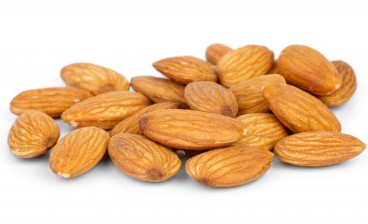 Roman Ivaschenko / 123RF Stock Photo 10693636
Roman Ivaschenko / 123RF Stock Photo 10693636
Almond Milk Pulp
If you ever make almond milk you can use the pasty stuff that's left over after the milk drains to make a cheese substitute. Just mix a bit of lemon juice to it, enough that it just tastes a bit tangy. The texture will be some what like ricotta cheese and when added to paleo pizza it's a pretty good substitute. Sorry I don't have any measurements for this as the amount of stuff left over after making milk isn't always the same so I just add the lemon juice to taste.
By Patti Vincent. Posted to the PaleoRecipe Mailing List, Feb. 2001
Dried, it makes a fantastic "flour"! I spread it out in a glass baking dish and turn the oven to 'warm'. Check it from time to time. When it's dry, you've got "flour". You can make muffins with it, pancakes (add eggs and coconut flour), whatever. I know, I know, this may be pushing the envelope for some, but if you're dying for a muffin or something, it does the trick. This is (obviously) lighter and lower in calories than finely ground almonds.
By Dori Zook. Posted to the PaleoRecipe Mailing List, Feb. 2001
To Print or Pin the Recipe, or to Post and/or Read
Comments
 Roman Ivaschenko / 123RF Stock Photo 10693636
Roman Ivaschenko / 123RF Stock Photo 10693636
Almond Milk w/o Juice
I use about 2 parts water to one part almonds. Play around, see what you like. I put this in the blender and have at it. Then, I take cheap panty hose (hey, this works best and no, they haven't been worn), cut off one leg about 1' from the end and use this to strain the mix into a bowl (or whatever). I then turn this straining device inside out, let the ground nut meal plop into a baking dish and repeat until the mix is done. As I posted before, I then put the pulp into the oven on 'warm' until dry. I put a few drops of stevia in the milk to get rid of the bitterness. There you have it, milk AND "flour". Nice bang for the buck, no?
By Dori Zook. Posted to the PaleoRecipe Mailing List, Feb. 2001
To Print or Pin the Recipe, or to Post and/or Read
Comments
 Roman Ivaschenko / 123RF Stock Photo 10693636
Roman Ivaschenko / 123RF Stock Photo 10693636
Almond Milk
The basic recipe I use is to soak almonds overnight, discard soaking water, then combine in a blender 1 part almonds to 3 parts water, and blend. If you have a good blender (I use a VitaMix), there's no need to strain; if not, strain with cheesecloth.
You can add sweeteners if you like (dates, honey or maple syrup are all pretty good), but they aren't necessray. One date or a tablespoon of honey is enough for 1/2 C almonds and 1 1/2 C water. A touch of vanilla extract or ground cinnamon is nice too (1/4 tsp).
By Bruce Sherrod. Posted to the PaleoRecipe Mailing List, Feb. 2001
To Print or Pin the Recipe, or to Post and/or Read
Comments
 Roman Ivaschenko / 123RF Stock Photo 10693636
Roman Ivaschenko / 123RF Stock Photo 10693636
Best Almond Milk
I don't much enjoy the almond milk recipe found in Neanderthin. The apple juice makes the finished milk too acidic and gives it a sort of fermented smell. Here is a juice-less recipe from my friend Jenna. The milk is absolutely divine served warm and frothy in a mug, with a touch of honey or stevia.
8 oz. blanched almonds
3 cups water (per batch; you'll get 4-6 batches from 8 oz. almonds)
2 Tbs. maple syrup, per batch (optional, and can be adjusted)
Soak almonds in just enough water to cover for 6 hours or overnight. Drain, discard soaking water. Put almonds and 3 cups water, 2 Tbs maple surup into a blender and process on "liquify" until the almonds are finely ground. The milk will be white and creamy.
Line a mesh colander with a linen towel or several layers of cheesecloth and place in a bowl. Pour the almond milk through the cloth, carefully gather the corners of the cloth and gently wring out the milk.
Return the ground almonds to the blender and repeat the process until the almonds yield no more milk. You'll get approximately two and a half quarts of milk. Store in jugs with tight-sealing caps, and use within two or three days.
You can use it to make strawberry milk: blend 1 cup of the finished milk with a few fresh or frozen strawberries, strain (if desired) and enjoy.
By Stacie Tolen. Posted to the PaleoRecipe Mailing List, Oct. 2001
To Print or Pin the Recipe, or to Post and/or Read
Comments
 Roman Ivaschenko / 123RF Stock Photo 10693636
Roman Ivaschenko / 123RF Stock Photo 10693636
Almond Milk
1 Part Almonds
4 Parts water
Blend. To activate almonds, soak overnight, pour off water, follow recipe above. For a delicious smoothie add: frozen fruit or pure maple syrup.
Courtesy of RAW Restaurant, San Francisco, from
RawTimes.com
To Print or Pin the Recipe, or to Post and/or Read
Comments
 Roman Ivaschenko / 123RF Stock Photo 10693636
Roman Ivaschenko / 123RF Stock Photo 10693636
Almond Milk
Start with whole almonds and soak them overnight in water. Next day, blanch the almonds (dip in boiling water) and remove the skins (they come right off). Purée in blender with water and maybe some sweetener and vanilla if you like. Filter out the grit and you have almond milk. Easy! From: Malcolm J. Sickels via rec.food.veg.cooking on Jul 28, 1996.
Alternate:
I don't bother blanching the almonds after soaking overnight. I just put them right into the blender with water and 1/2 a banana. Delishes! More almonds and banana = thicker milk.
From: Rona@rona.com ("Rona H. Halpern, Ph.D.")
To Print or Pin the Recipe, or to Post and/or Read
Comments
 Roman Ivaschenko / 123RF Stock Photo 10693636
Roman Ivaschenko / 123RF Stock Photo 10693636
Almond Milk (candida directory and cook book)
This delicatly flavored milk is a great addition to many foods. It brings competing flavors into a state of detente. Made thickly, it can be used as a spread or thickener for soup. The ratio of almonds to water varies in our recipe to allow you to choose between a spread or milk-like consistency.
1 cup of almonds, freshly roasted
2 1/4 to 4 cups water.
Place the almonds and water (2 1/4 cups for topping or spread, 4 cups for drinking) in a tightly closed jar and store in the refringerator for 1 to 2 days at the most. Pour into a blender and blend until the mixture is smooth. To use it as a drink, strain first. The remaining almond paste is delicious and can be tossed on cereal, vegetables or rice.
From: Kate Sholl via the Yeast-L List
To Print or Pin the Recipe, or to Post and/or Read
Comments
 Roman Ivaschenko / 123RF Stock Photo 10693636
Roman Ivaschenko / 123RF Stock Photo 10693636
Almond Milk
No, don't boil it! Just put about 1/2 cup of almonds in a blender and grind them up. Add about 3 cups of water, blend for about 2 minutes. (It will be very white and creamy.) Then strain it and refrigerate. It tastes better if you also add about a tablespoon of maple syrup.
From: smb@eznets.canton.oh.us (Steve) via sci.med.nutrition
To Print or Pin the Recipe, or to Post and/or Read
Comments
 Roman Ivaschenko / 123RF Stock Photo 10693636
Roman Ivaschenko / 123RF Stock Photo 10693636
Nut Milk [Almond]
This can be used to replace milk in recipes that taste odd when made with commercial soy or rice milks. I use this for custards and puddings, since soy milk can take on a nutty taste when used in these. It is fine to drink, also. The fat content depends upon the type and quantity of nuts used. More nuts in proportion to water gives a richer milk. This is somewhere between whole milk and half-and-half in richness.
1 cup + approx. two tabls. almonds (blanched*) -- use less for a less rich milk (1/2 cup = skim milk?)
2 1/2 cups water
Put nuts and water in a blender. Blend approximately 2 minutes (more or less, depends on your blender. The nuts should be pulverized.) Strain the resulting stuff to remove the nut chunks. (I use a mesh coffee filter [ex. Melitta gold filter] and a rubber spatula to force the liquid through. Paper coffee filters are too fine, and kitchen seives are too coarse.) This makes 2 cups, approximately.
* blanching the almonds (dipping in hot water for 30 seconds then removing the brown skins) results in a much prettier milk. The little brown flecks don't filter out so well. Yield: 2 cups
From: the Allergies and Asthma FAQ:
www.cs.unc.edu/~kupstas/FAQ.html [archive.org]
To Print or Pin the Recipe, or to Post and/or Read
Comments
 Roman Ivaschenko / 123RF Stock Photo 10693636
Roman Ivaschenko / 123RF Stock Photo 10693636
Almond Milk
You need:
a simple blender or Vita-Mix
one medium-size fine strainer
cheesecloth to line the strainer (optional)
a large bowl
a pitcher with lid, for storage
Blanch almonds by placing them in 1 cup boiling water. Allow them to stand until the water has cooled slightly, and then peel off skins, or prepare milk with unblanched almonds. (Milk from blanched almonds will be slightly whiter in color and smoother in consistency with no difference in flavor.) Dry almonds well.
1/2 cup shelled raw almonds
1/2 tablespoon pure maple syrup (optional)
2 cups water
1. Place almonds in blender and grind to a fine powder. Add sweetener and 1 cup water. Blend again for 1 to 2 minutes to form a smooth cream.
2. With blender running on high, add remaining cup of water slowly through opening of blender lid. Blend 2 minutes.
3. Place the strainer over a large bowl; to ensure a smooth milk, line the strainer with cheesecloth. (If you do not have cheesecloth, you can simply strain your milk twice, using an even finer strainer the second time.)
4. Pour almond milk slowly into strainer and allow to filter through. Add liquid to strainer in increments and just let it drain naturally, or stir the milk in the strainer with a spoon to encourage it to pass through more rapidly.
5. When all the milk has passed through the strainer, there will be approximately 1/2 cup of almond fiber accumulated. If you have used a cheesecloth liner, you can pull the edges together and gently squeeze the remaining milk out of the fiber, or use a spoon to gently press the remaining milk through the strainer. (The fiber can be stored in the refrigerator for a few days and used as a moisturizing body scrub when you shower.)
Makes about 2 cups.
Note: The amount can be doubled if you need a quart of Almond Milk. Almond Milk will keep in the refrigerator for 4 or 5 days. Store it in a jar or pitcher with an airtight lid.
Other Nut and Seed Milks
Using the same equipment, ratio of ingredients, and procedure, you can make wonderful milks from sesame seeds, sunflower seeds, or cashews.
From:
The American Vegetarian Cookbook by Marilyn Diamond.
Via: Cathy Flick on Yeast-L list
To Print or Pin the Recipe, or to Post and/or Read
Comments
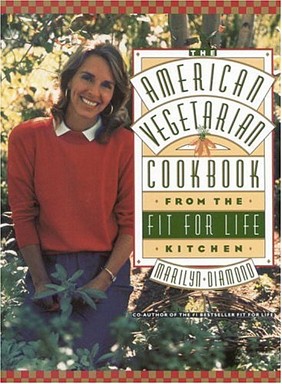
Pure and Sweet Almond Milk
1/3 c. organic raw almonds
1 Tbs. raw honey
3- 3 1/4 c warm water
1. In a one- to two- quart saucepan, heat approximately four cups of pure water to desired temperature. Turn stove off and allow to sit while you prepare the other ingredients.
2. Place approximately one fourth to one third cup of nuts in the grinder. Cover to activate grinding blades. Press and release a few times to grind the nut mixture, which should resemble a fine powder within about fifteen to twenty seconds. Transfer the ground mixture to a blender.
3. To your blender add a sweetener of your choice. Then add one half to three fourths cup of the warm or hot water (from your stove top) and blend on medium speed to a smooth, pudding like purée. Add the remaining water suggested in the recipe and re-blend on high speed until creamy.
Use approximately three cups of water per recipe for extra creamy nut milks, and use as much as one half to three fourths cup more for a thinner version. Amounts are suggested in the recipes; you may choose to vary them, as well as the water temperature.
4. Pour the contents of the blender through a fine mesh strainer into a bowl or pitcher. Use a spoon to stir the milk while you pour, since it will be slightly too rich to flow through the strainer without a bit of mashing. (Food fibers strained from drinks may be used in baked goods recipes)
Serve immediately or bottle and refrigerate for up to seventy-two hours.
From
Not Milk...Nut Milks!, by Candia Lea Cole via Piper on LOWCARB-LIST
To Print or Pin the Recipe, or to Post and/or Read
Comments
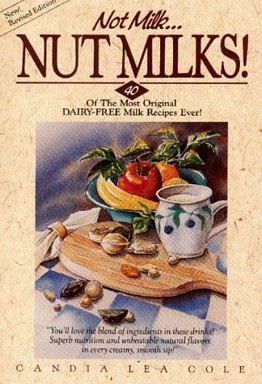
Macadamia Nut Milks
Macadamia Nut Milk
Slightly sweet and a nice thick texture.
1 cup raw, unsalted Macadamia Nuts
4 cups water
1/2 tsp vanilla extract
Sweetener of choice (I used 1.5 Tbsp maple syrup for one batch and 10 stevia drops for another and both tasted great)
Place nuts in a bowl and cover with water and allow to soak overnight or at least 7 hours to soften the nuts so they blend easier. I let mine sit for almost 20 hours on accident but it was fine. Drain the water off and rinse the nuts in a strainer.
Place nuts in a blender and pour in 4 cups of fresh water (not the water you soaked the nuts in). Blend on high for 2-3 minutes.
Over a deep bowl place the cheese cloth and secure the edges under the bowl itself. Pour the nut mixture over the cheesecloth and use a spoon to press out more of the milk from the nut meal that remains. You can also pick up the cheese cloth and knead out more of the milk with your hands. You may have to do this in a few batches depending on how deep and large your bowl is. Place the resulting nut meal in a bowl*
Pour milk back into the blender and add vanilla and sweetener and blend until combined. Taste and add more sweetener if you prefer. You can also strain a second time if you want an even smoother texture but I sort of like the nutty, thick texture that straining it one time gives it.
Viola! Homemade macadamia nut milk. Store in a tight jar in the fridge, it should keep about a week.
I also made a second batch using almonds and stored it in the freezer for later use.
* Don't throw away the nut meal that is leftover. You can make a flour out of it by placing it on a baking sheet in your oven's lowest temperature for about 20 minutes. Store in the fridge and use in baked goods.
From:
katie did [archive.org]
To Print or Pin the Recipe, or to Post and/or Read
Comments
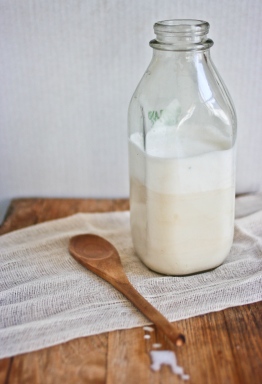 katie did
katie did
General Nut Milk Info
Nut Milk
1 cup Nuts
2 cups Water
1 Banana
1/2 tablespoon raw honey
Liquify in blender.
Adapted from:
RawTimes.com
To Print or Pin the Recipe, or to Post and/or Read
Comments
Basic Recipe for Nut Milk
1/2 cup chopped nuts (almonds or other nut is your choice, unroasted)
2 cups water, best if warm
1 tsp. raw honey or pure maple syrup
Blend nuts and all other indredients in a blender until smooth. Strain mix and refrigerate for up to 3 days. You can use the strained material as a thickener for a soup or stew as long as its not too sweet. It is a shame to throw it out so find a way to use it.
If you are on a rotation diet you can vary the cooking liquid that you use by the day by using different nuts. I use nut milk for cooking and baking.
Adapted from: Larissa Blechman via No-Milk Mailing List
To Print or Pin the Recipe, or to Post and/or Read
Comments

Nut Milk
A milk made from raw nuts can often be used in place of dairy milk. To make a nut milk, liquefy one cup of blanched almonds with 4 cups of water in a blender. Add 2 Tablespoons raw honey or pitted dates for sweetness; decrease water for creamier milk.
From:
Natural Foods Cookbook by Maxine Atwater
To Print or Pin the Recipe, or to Post and/or Read
Comments
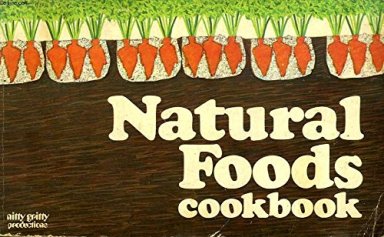
Worry Free Milk
I got tired of worrying what milk has gluten or casein in it so here's a solution I got from The Yeast Connection Cookbook. I make nut milk--you can rotate the nuts and, therefore, rotate the type of milk you use everyday. I use it for baking, shakes and cereal, but I don't know if it would be good to drink on its own. Oh, and it's much cheaper than buying other types of milk.
Here's a basic recipe. Take 1/2 cups of nuts. Blend them to a fine meal. Add two cups of water (optional 1 teaspoon of liquid sweetener...pure maple syrup, raw honey, etc). Blend. Strain through a fine mesh strainer.
From: Tammy Glaser via bit.listserv.autism
To Print or Pin the Recipe, or to Post and/or Read
Comments

Nut Milk
Put 1/2 cup raw pecans, almonds, walnuts, Brazil nuts, etc., into a blender container. Process until ground. Add 1/2 cup water and process at low speed for a few seconds, then turn blender to high. Blend for a couple of minutes, then add 1 1/2 cups water. Blend well.
If milk is grainy (almonds and some other nuts and seeds are, but none on the above list), strain through a few layers of cheesecloth. Use the pulp in your next batch of bread.
Store in the refrigerator.
From: Marilyn Gioannini, Author of
The Complete Food Allergy Cookbook
To Print or Pin the Recipe, or to Post and/or Read
Comments
Coconut Milks
Easiest Coconut Milk
1 cup dried unsweetened shredded coconut
water to make 5 cups of coconut milk
Sweetener (optional. If using, add a dash of salt as well.)
Grind the coconut in your blender or spice grinder until fairly finely ground. (I love this coffee grinder. I think you get a better grind in this than in the blender.)
Add 1 cup of water to the ground coconut in a high powered blender (like Vitamix) and blend on high for 1 minute.
Add water to make 5 cups of coconut milk. Blend on high for 3 minutes.
Enjoy and store in the refrigerator.
By Adrienne at
Whole New Mom
To Print or Pin the Recipe, or to Post and/or Read
Comments
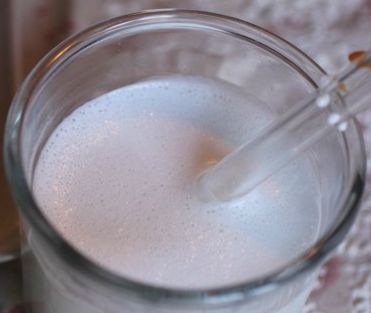 wholenewmom.com
wholenewmom.com
Coconut Milk
In a blender or food processor, combine 1/2 cup each grated unsweetened coconut and boiling water. Blend until coconut is finely ground. Strain thru a fine sieve or a piece of clean muslin, squeezing to extract all the liquid. Discard coconut. Makes about 1/2 cup.
From:
Regional American Classics, California Culinary Academy.
To Print or Pin the Recipe, or to Post and/or Read
Comments
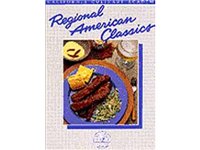
Fresh Coconut Milk
I decided to be a bit adventurous on this one. Having read on the can that coconut milk is made from steamed coconut, I figured I could make it fresh. I bought a coconut and after much effort, and several friends making suggestions, I finally got it open. Actually, a hammer and screwdriver works best. Then I took the meat out and boiled it with bottled water. One medium coconut made about 6 cups of milk/broth. I imagine it will work the same.
From: Gaylen (mtharp266 at @aol.com)
Colleen then put the milk and some ice in a blender and made a frosty shake.
To Print or Pin the Recipe, or to Post and/or Read
Comments
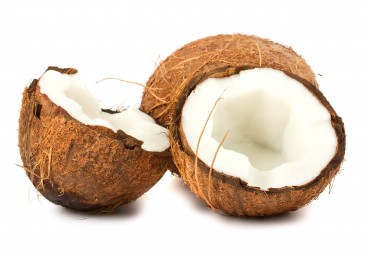 Andrey Eremin / 123RF Stock Photo 10984930
Andrey Eremin / 123RF Stock Photo 10984930
Coconut Milk
The way I was taught in the Philippines by my sister in-law was to grate down the coconut, add a little water, allow to stand, place in muslin and then squeeze out the milk. The first squeezing is the superior quality milk adding more water and re-squeezing produces a weaker lower quality milk. Given this production method, the oily coconut solid invariably separate from the water. Filipino cooking actually uses these as two separate ingredients.
If you cook down the solids, it forms coconut oil, brown crispy solids which again get used in Filipino cookery for cakes and candies.
From: Guy C. Reynolds in rec.food.cooking on Jan 25, 1999.
To Print or Pin the Recipe, or to Post and/or Read
Comments
 Andrey Eremin / 123RF Stock Photo 10984930
Andrey Eremin / 123RF Stock Photo 10984930













